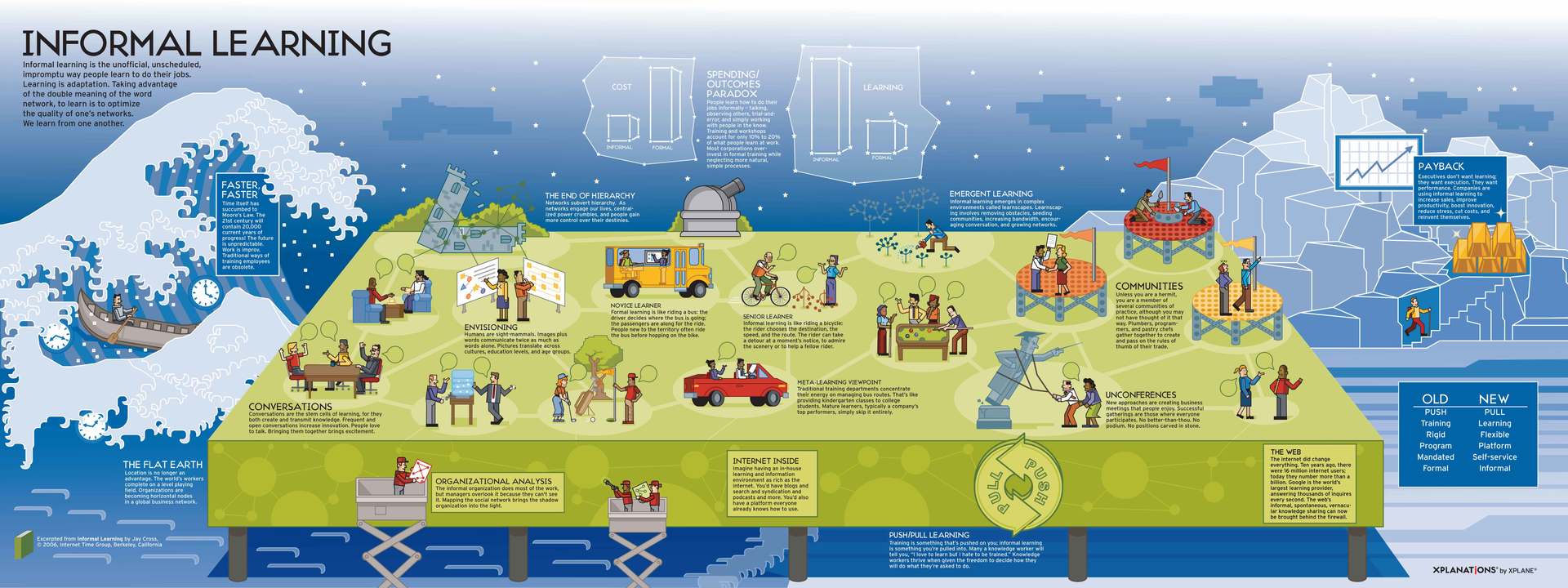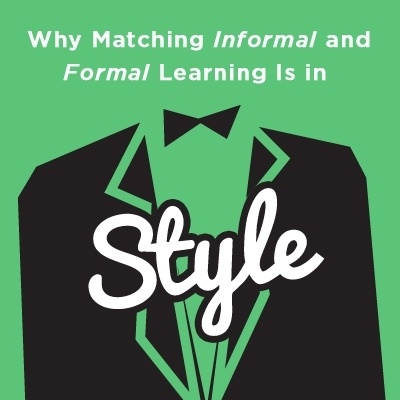How To Create A Hybrid, Formal And Informal Learning Course For Your Employees
How can you strike an L&D balance with formal and informal learning? The 70:20:10 rule for learning isn’t supposed to be an excuse for leadership to under-invest in Learning and Development, or to abandon their corporate learners. This approach is so popular in organizations because it represents reality. Most valuable learning does, indeed, take place “on the job” (the 70%). That’s informal learning. Social learning, and learning from a mentor, is the next largest chunk of learning opportunity. We learn from the experience of others. That leaves us with 10% of learning experiences as classroom-based, formal learning. How can we use the latest learning technology to promote a new way of bringing together the 100%?
Formal Vs. Informal Learning
Traditionally, an individual development plan would consist of a list of online training courses to attend, and perhaps some networking opportunities. Did anyone really learn and grow through that type of approach? Do we really learn more from absorbing materials in a classroom? Isn’t it just as valuable to gain experience in the real world? Of course, we know that experienced-based learning alone can lead to misjudgments and errors. We must combine a strong base of theory and assessment-based learning with the opportunities to put those skills into practice. That’s where the vast range of learning technologies available can help create a hybrid approach, combining formal and informal learning.
Creating A Hybrid, Formal And Informal Learning Approach
Can we create an online environment that promotes both formal and informal learning? Within the online training world, we have moved so far from the traditional read – test – complete course model. Now, we can inspire and engage corporate learners with technology that allows them to play, test, and fail in a safe way. This is the start of the hybrid, formal and informal learning approach that will bring that 70:20:10 model to corporate eLearning. Informal learning by definition is mostly unconscious and undefined. However, there are ways to integrate this approach into a structured corporate eLearning environment. Let’s explore those a little more:
1. Gamification
Take the corporate learner outside of the formal learning mindset with gamification. A game can replace a quiz or a test, and can be just as effective at assessing understanding. Games have a fantastic impact on the engagement of a corporate learner and allow them to really escape into a scenario. Far from formal, but alongside formal content – you’d classify this type of learning in the 70%. Remember to chunk your games into microlearning modules. These can be done at any time, anywhere, even from the comfort of their home office.
2. Social Learning
Taking a formal online training course and turning it into a conversation outside of the online training environment is an effective embedding tool. Social learning also helps further personal development and increases engagement, as corporate learners feel more connected to their peers. This can be as simple as an online discussion platform to talk about the build-up to a piece of training, or a feedback platform. Create competition and celebrate success by creating challenges. Connect your formal online training course to a social platform to help truly embed the learning and deliver the best of informal and formal learning.
3. Experiential Learning
Virtual Reality, simulations, and branching scenarios are all examples of experiential learning – classic examples of informal learning, taken online. Since informal learning is ideally based in the real world, why not let corporate learners experiment in a Virtual Reality? Take that learning they have just absorbed from text, video or audio, and transport the corporate learner into their workplace (virtually, of course). Give them a chance to try out their new skills and make mistakes, which is also a vital part of learning. You can also schedule impromptu discussions after the fact so that employees can discuss performance issues and reflect on personal areas for improvement.
4. Self-Guided Online Training Activities With Real-Time Follow Up
Give employees the opportunity to explore topics on their own, then collaborate with peers and online instructors to broaden their understanding. For example, corporate learners begin by researching the subject matter through online articles, videos, and the online training library. This is followed by a live online training event that allows them to discuss the topic with their co-workers and share their insights. You can even invite them to develop a presentation or infographic based on their findings, and upload it to the learner-generated repository. This facilitates peer-based feedback and expands your online training library without putting you over budget.
5. Webinars And Workshops
Online training events offer employees a good balance of formal and informal learning. A webinar or workshop provides structure and guidance for corporate learners who may lack the initiative or experience. It gives them a framework to follow. For instance, a brief introduction to the topic that serves as a springboard for peer-to-peer interactions. Pair these online training events with social media groups and blogs to deepen their understanding and give them the chance to explore ideas in a group setting. They can even host their own online training events to reinforce their knowledge and share their unique expertise.
Conclusion
When developing a hybrid formal/informal learning model, we also need to think about how we deliver online training. Make online training courses responsive so that they run on any device. This takes learning from a formal setting to an informal setting (train, café, sofa, etc.). Think about how to take that online training course you are developing and work in the 70:20:10 model. Can you connect your corporate learners with their peers to fill gaps in understanding? Could you add in a simulation that turns the theory into practice? Can you release a game which trains, tests and engages all at once? Don’t limit online training to the formal. Release your corporate learners to the world of practice, experience and collaboration with a hybrid, formal and informal learning approach.
Can your organized and structured LMS help you create spontaneous informal learning? Find the right LMS for your remote staffers (and budget) using our exclusive online directory. It features the leading learning management systems with gamification and social learning support.









